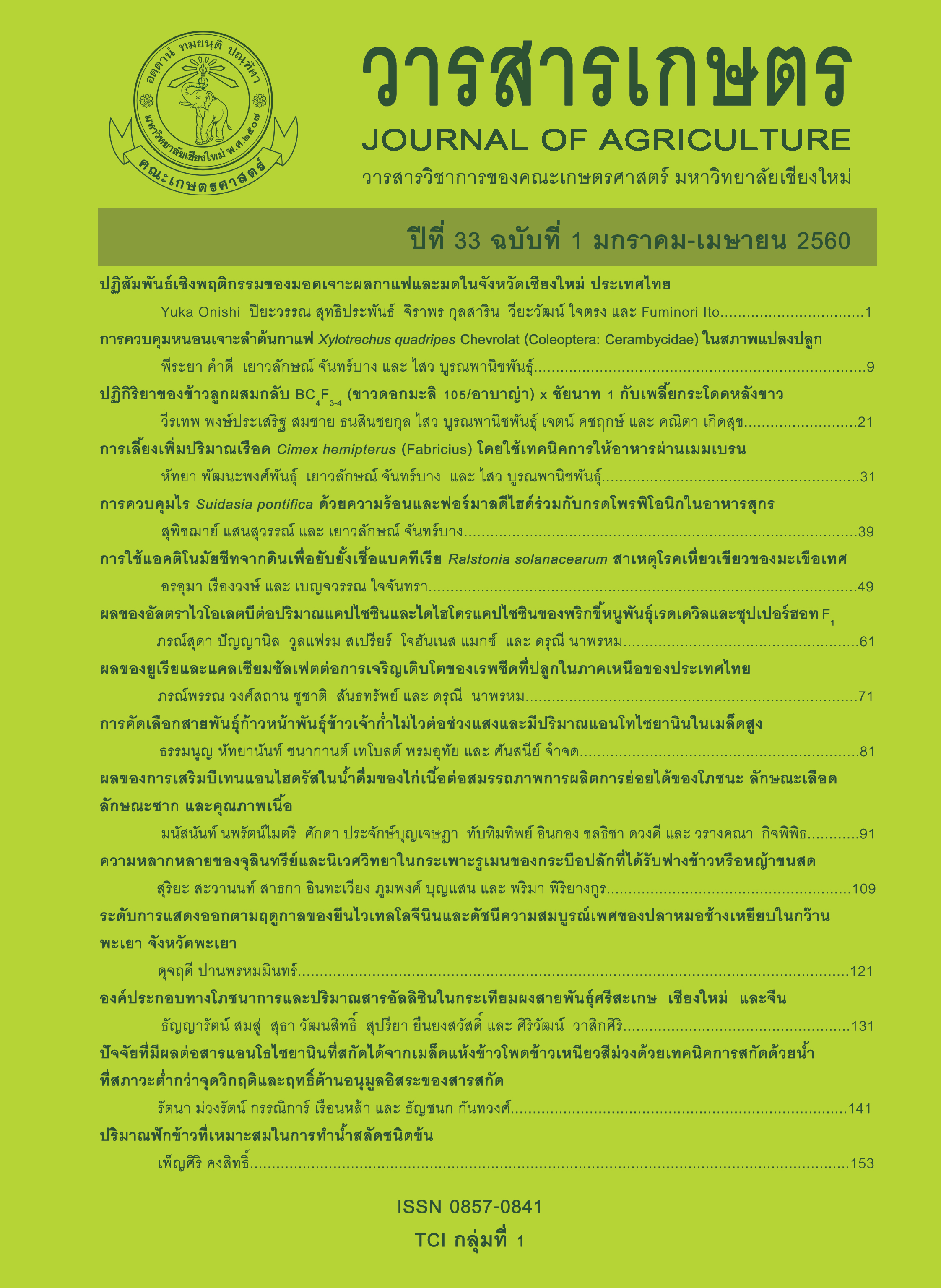การใช้แอคติโนมัยซีทจากดินเพื่อยับยั้งเชื้อแบคทีเรีย <I> Ralstonia solanacearum </I>สาเหตุโรคเหี่ยวเขียวของมะเขือเทศ
Main Article Content
บทคัดย่อ
การแยกเชื้อแอคติโนมัยซีทจากดินบริเวณรอบรากของต้นมะเขือเทศในแปลงปลูกของสถานีเกษตรหลวงอินทนนท์และศูนย์พัฒนาโครงการหลวงขุนวาง สามารถแยกเชื้อได้จำนวน 126 ไอโซเลท เมื่อคัดเลือกเชื้อที่มีประสิทธิภาพในการยับยั้งการเจริญของเชื้อแบคทีเรีย Ralstonia solanacearum สาเหตุโรคเหี่ยวเขียวของมะเขือเทศ ด้วยวิธี dual culture บนอาหาร NA พบแอคติโนมัยซีทที่เป็นปฏิปักษ์ จำนวน 17 ไอโซเลท โดยไอโซเลทที่มีประสิทธิภาพมากที่สุดในการยับยั้งการเจริญของเชื้อสาเหตุโรค คือ ไอโซเลท T-11 ซึ่งมีความกว้างบริเวณยับยั้ง เท่ากับ 16.50 มิลลิเมตร เมื่อนำไอโซเลท T-11 มาตรวจสอบการสร้างสารสำคัญบางชนิด พบว่าไอโซเลท T-11 สามารถสร้างสาร siderophore และสร้างเอนไซม์เซลลูเลสบนอาหารทดสอบได้ และเมื่อทำการจัดจำแนกชนิดของไอโซเลท T-11 โดยการวิเคราะห์ลำดับนิวคลีโอไทด์บริเวณยีน 16S rRNA พบว่าไอโซเลท T-11 มีลำดับนิวคลีโอไทด์บริเวณดังกล่าวเหมือนกับเชื้อ Streptomyces mirabilis ถึง 96 เปอร์เซ็นต์
Article Details
เอกสารอ้างอิง
จิระเดช แจ่มสว่าง. 2546. การควบคุมโรคพืชและแมลงศัตรูพืชโดยชีววิธี. ภาควิชาโรคพืช คณะเกษตร มหาวิทยาลัยเกษตรศาสตร์ วิทยาเขตกําแพงแสน, นครปฐม. 204 หน้า.
มณีฉัตร นิกรพันธุ์. 2554. พริก มะเขือเทศ. โอ. เอส. พริ้นติ้งเฮ้าส์, กรุงเทพฯ. 271 หน้า.
สุชีลา เตชะวงค์เสถียร ชานนท์ ลาภจิตร เกศจิตต์ ขาม-คุลา จันทร์แรม คำหนู วุฒิพงษ์ ยคหล้า ธงชัย ประสมสวย และภราดร สื่อมโนธรรม. 2552. การปรับปรุงพันธุ์มะเขือเทศรับประทานสดผลเล็ก. วารสารโครงการหลวง 13(2): 2-10.
Abdulla, H.M. and S.A. El-Shatoury. 2006. Actinomycetes in rice straw decomposition. Waste Management 27(6): 850-853.
Boudjella, H., K. Bouti, A. Zitouni, F. Mathieu, A. Lebrihi and N. Sabaou. 2006. Taxonomy and chemical characterization of antibiotics of Streptosprangium Sg10 isolated from a Saharan soil. Microbiological Research 161(4): 288-298.
Challis, G.L. and D. Hopwood. 2003. Synergy and contingency as driving forces for the evolution of multiple secondary metabolite production by Streptomyces species. Proceedings of the National Academy of Sciences 100 Suppl2: 14555-14561.
Coombs, J.T. and C.M.M. Franco. 2003. Isolation and identification of actinobacteria from surface-sterilized wheat roots. Applied and Environmental Microbiology 69(9): 5603-5608.
El-Sayed, M.H. 2012. Di-(2-ethylhexyl) phthalate, a major bioactive metabolite with antimicrobial and cytotoxic activity isolated from the culture filtrate of newly isolated soil Streptomyces (Streptomyces murabilis Strain NSQu-25). World Applied Sciences Journal 20(9): 1202-1212.
Hankin, L. and S.L. Anagnostakis. 1977. Solid media containing carboxymethylcellulose to detect Cx cellulase activity of micro-organisms. Journal of General Microbiology 98(1): 109-115.
Jeffrey, L.S.H. 2008. Isolation, characterization and identification of actinomycetes from agriculture soils at Semongok, Sarawak. African Journal of Biotechnology 7(20): 3697-3702.
Kelman, A. 1954. The relationship of pathogenicity of Pseudomonas solanacearum to colony appearance in a tetrazolium medium. Phytopathology 44(12): 693-695.
Ko, W.H., Y.J. Tsou, M.J. Lin and L.L. Chern. 2010. Activity and characterization of secondary metabolites produced by a new microorganism for control of plant diseases. New Biotechnology 27(4): 397-402.
Louden, B.C., D. Haarmann and A.M. Lynne. 2011. Use of blue agar CAS assay for siderophore detection. Journal of Microbiology & Biology Education 12(1): 51-53.
Mendez, C., A.F. Brana, M.B. Manzanal and C. Hardisson. 1985. Role of substrate mycelium in colony development in Streptomyces. Canadian Journal of Microbiology 31(5): 446-450.
Nolan, R.D. and T. Cross. 1988. Isolation and screening of actinomycetes. pp. 1-32. In: M. Goodfellow, S.T. Williams and M. Mordarski (eds.). Actinomycetes in Biotechnology. Academic Press, San Diego.
Prior, P., C. Allen and J. Elphinstone. 1998. Bacterial Wilt Disease: Molecular and Ecological Aspects. Springer-Verlag, Berlin. 447 p.
Sadeghi, A., A.R. Hessan, H. Askari, S. Aghighi and G.H. Shahidi Bonjar. 2006. Biological control potential of two Streptomyces isolates on Rhizoctonia solani, the causal agent of damping-off of sugar beet. Pakistan Journal of Biological Sciences 9(5): 904-910.
Saile, E., J.A. McGarvey, M.A. Schell and T.P. Denny. 1997. Role of extracellular polysaccharide and endoglucanase in root invasion and colonization of tomato plants by Ralstonia solanacearum. Phytopathology 87(12): 1264-1271.
Schaad, N.W. 1988. Laboratory Guide for Identification of Plant Pathogenic Bacteria. The American Phytopathological Society, St. Paul, Minnesota. 158 p.
Sharifi, F., G.H. Shahidi Bonjar, S. Aghighi, P. Rashid Farrokhi, E. Khalesi, M.J. Mahdavi and H. Taraz. 2007. Antagonistic potential of Iranian native Streptomyces strains in biocontrol of Pythium aphanidermatum. Resarch Journal of Biological Sciences 2(3): 232-235.
Swan, D.G., A.M. Rodriguez, C. Vilches, C. Mendez and J.A. Salas. 1994. Characterisation of a Streptomyces antibioticus gene encoding a type I polyketide synthase which has an unusual coding sequence. Molecular and General Genetics 242(3): 358-362.
Xie, B., J. Yang and Q. Yang. 2010. Isolation and characterization of an efficient nitro-reducing bacterium, Streptomyces mirabilis DUT001, from soil. World Journal of Microbiology and Biotechnology 26: 855-862.


